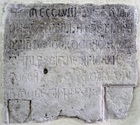The collection is split between Palazzo Bianconi (below), and two locations in Palazzo Comunale:
-
✴the Lapidarium (below); and
-
✴Sala Zuccari - see the page on Palazzo Comunale.
Palazzo Bianconi
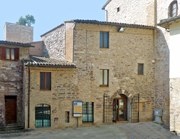
Grave Goods
The collection includes a display of grave goods from what seems to have been a large necropolis that extended from Portonaccio towards the railway station. The necropolis was first excavated in 1977. Many of its graves had been disturbed, either by earlier clandestine excavation or by natural phenomena.
The excavation was carried in two phases:
-
✴In 1977, attention focused on two inhumation tombs (designated tombs 1 and 10) near Portonaccio which were essentially undisturbed.
-
•The grave goods in Tomb 1 included a pair of dice and two coins produced in 217-5 BC.
-
•The grave goods in Tomb 10 belonged to a noble lady, and included three coins, one of which has been dated to 179 BC, as well as her mirror and perfume flask (below)
-
•A fibula (7th century BC) was found nearby.
-
✴An older inhumation tomb (ca. 300 BC) was discovered 1979, during the excavation of a Roman villa in Via Baldini (to the south). Some of the grave goods had been imported from Etruria.
Mirror (ca. 200 BC)
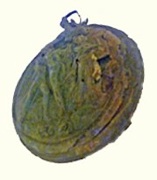
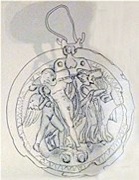
This bronze object is made up of the mirror itself and a decorated cover. This depicts the drunken Dionysus held up by a winged figure, while a lady on his left plays the zither.
Perfume Flask (ca. 200 BC)
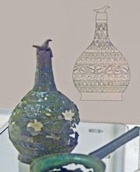
num [i]u
perhaps “Numisius Iunius”
The inscription is, and is also described on this site in the page on Umbrian Inscriptions after 295BC.
Inscription
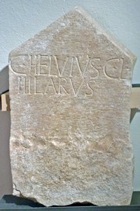
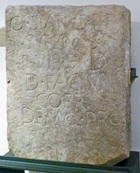
-
✴Quintus Statius, son of Publius; and
-
✴Publius Safena, son of Titus.
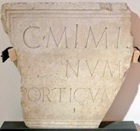
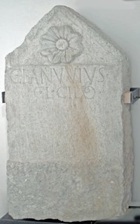
Lapidarium of Palazzo Comunale
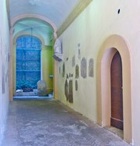
Inscriptions Commemorating Magistrates
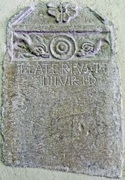
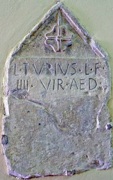
CIL XI 5282: Titus Laterius CIL XI 5288: Lucius Turius
quattuorvir iure dicundo quattuorvir aedillis
Two funerary inscriptions (illustrated above), which both date to the 2nd half of the 1st century BC) commemorate quattuorviri:
-
✴CIL XI 5282 (on the left), which came from an unknown location in Spello and which had been reused in casa Donnola there, commemorates Titus Laterius, son of Titus, who had been quattuorvir i(ure) d(icundo); and
-
✴CIL XI 5288, which came from an unknown location in Spello and which had been reused in the collegiata di San Lorenzo there, commemorates Lucius Turius, son of Lucius, who had been quattuorvir aed(illis).
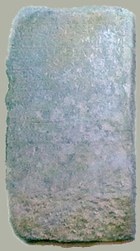
Cn(aeus) Aequasius C(ai) f(ilius) Calvo[s]
L(ucius) Aelius L(uci) f(ilius) IIvir(i) i(ure) d(icundo)
ex d(ecreto) d(ecurionum) viae latitudin(i)
diecer(unt) substruction(es)
et erismas fac(iundum) loc(averunt)
in id opus ex d(ecreto) d(ecurionum) pecu(nia)
lud(orum) HS LXXX(milia) [...]
Cn(aeus) Aequasius C(ai) f(ilius) Calvo[s]
L(ucius) Aelius L(uci) f(ilius) IIvir(i) i(ure) d(icundo)
M(arcus) Suestidius L(uci) f(ilius)
C(aius) Arrenus M(arci) f(ilius) IIvir(i) i(ure) d(icundo)
deder(unt) idemq(ue) proba(ve)r(unt)
The decree was additionally approved by another pair of duoviri:
-
✴Marcus Suestidius; and
-
✴Caius Arrenus;
who presumably held office in the following year.
Titus Valerius (4 - 19 AD)
An inscription (CIL XI 5289) in the deposit of collection, which was found at an unknown time near Porta Consolare, records:
T(itus) Valeriu[s ---]/ praef(ectus) Germ[anici Caesaris ---]
At Foligno, Ludovico Jacobilli apparently had a very similar inscription (CIL XI 5224) in his atrium, which was probably (like other inscriptions in his collection) from Spello. It read:
[p]raefecto ex s(enatus) c(onsultato/ [Germanici Caesar[is]
Ti{beri) Augusti f(ilio), divi Augu[sti]/ n(epos) quinq(uennali) po([t(estate)]
Maria Carla Spadoni (referenced below, at pp. 93-4, entry 107) observed that these inscriptions:
-
“... presumably relate to the same person, who was praefectus quinquennalis of Germanicus at the colony of Hispellum” (my translation).
Germanicus, who was actually Tiberius’s nephew, became his son by adoption in 4 AD and died in 19 AD, which allows the dating of the inscription.
Caius Matrinius Aurelius Antoninus (4th century AD)
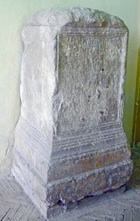
Other Inscriptions

This inscription (CIL XI 5328, 1st century BC ), which was embedded in the facade of Santa Barbara in the 16th century, commemorates Caius Otacilius, son of Lucius.
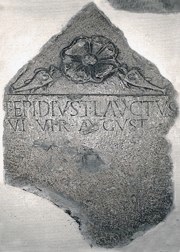
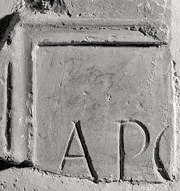
Apollini sa[crum ---]
ob honor[em] [Iviratus?]
Vetrov(ius?) D̲[---]
Vetrovi[---]
Linda Baiolini (referenced below, at p. 98) suggested that this inscription possibly related to a temple dedicated to Apollo, which might have stood on a podium that has been excavated at the southern end of the forum.
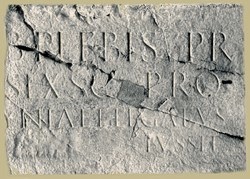
A fragmentary inscription (CIL XI 5272) that was re-used in the pavement of Santa Maria Maggiore might commemorate Pliny the Younger and date to the last year of his life (112 AD), when he was the governor of the province of Bithynia et Pontus as legate of the Emperor Trajan.
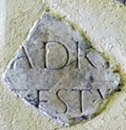
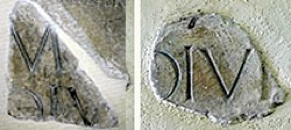
CIL XI 5267 CIL XI 5268
These fragments relate to imperial inscriptions:
-
✴The fragment of CIL XI 5267 on the left was discovered in 1790 in the orchard of San Filippo. The surviving text reads:
-
...ADRI.../ ... TEST X
-
It probably commemorated the Emperor Hadrian and dated to the 10th year of his tribunician power (120-1 AD)
-
✴The two fragments of CIL XI 5268 on the right are from an unknown location in Spello. The surviving text reads (respectively:
-
... M ... / ... DIV ...
-
... DIVI ...
-
These probably belonged to an imperial inscription of the 2nd century AD.
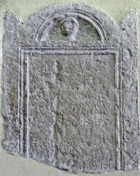
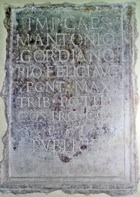
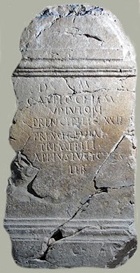
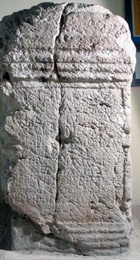
Other Roman Remains
Fragments from the Theatre (late 1st century BC)
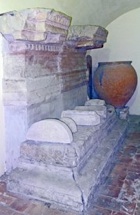
Figure in a Toga
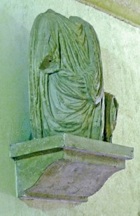
Sarcophagus (3rd century AD)

This side panel from a sarcophagus contains an image of the deceased with winged spirits and garlands.
Remains from Rocca Baglioni
Anno Domini M CCC LVIII
Philippus de Antilla, episcopus Florentius
rector ducatus Spoletani
fecit hedificare istam roccum
tempore domini Innocentii pape VI
This records that Bishop Filippo dell’ Antella of Florence (whom Pope Clement VI had appointed as rector of the Duchy of Spoleto in 1353) had commissioned this fortress in 1358. In fact, Filippo dell’ Antella left the duchy in January 1358 to take up his appointment in Florence, so the commissioning of this fortress must have been among his last acts as rector.
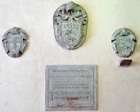
Read more:
S. Sisani, “I Rapporti tra Mevania e Hispellum nel Quadro del Paesaggio Sacro della Valle Umbra”, in
G. Della Fina (Ed.), “Il Fanum Voltumnae e i Santuari Comunitari dell’ Italia Antica”, (2012) Orvieto (pp. 409-64)
P. Bonacci and S. Guiducci, “Hispellum: La Città e il Territorio”, (2009) Spello
M.C. Spadoni, “I Prefetti nell' Amministrazione Municipale dell' Italia Romana”, (2004) Bari
L. Baiolini, “ La Forma Urbana dell' Antica Spello”, in:
L. Quilici and S. Quilici Gigli (Eds), “Città dell' Umbria”, (2002) Rome, pp 61-120
Return to Monuments of Spello.


